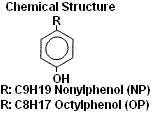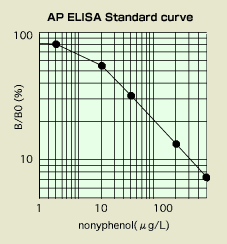|
AP ELISA Kit
- The monoclonal antibody binds exclusively with Alkylphenol(AP) , and does not cross-react with other surfactants or compounds of similar structure.
- The detection range is between 5μg/L and 500μg/L. A simple concentration protocol based on solid phase extraction is available to determine much lower concentration.
- With ease of handling, the total time for measurement is only 2.5 hours.
- The kit, a 96-well microplate format, enables simultaneous measurement
of multiple samples at more reasonable cost.
AP
 AP
is suspected as one of the endocrine disrupting chemicals in many countries.
AP
is suspected as one of the endocrine disrupting chemicals in many countries.
Octylphenol (n=8) and nonylphenol (n=9) are widely used as raw material of surfactants and anti-oxidants.
AP is generated by microbial decomposition of ethylene oxide chains in APE, which is widely used as nonionic surfactant.
NPnEC, another decomposed product of APE, is also assumed as hormone mimicking chemicals.
AP Standard Curve
 |
Samples containing AP within the dynamic range (5μg/L-
500μg/L) can be directly applied to assay after filtration. Samples with AP content
below the range must be concentrated with solid phase extraction prior to the
ensuing session. Coefficient of variation(CV) is generally under 10% throughout the dynamic range. |
Pretreatment (Simplified Solid Phase Extraction)
If an extraction and a concentration process is not necessary,
add methanol to the filtrate to be a final DMSO concentration of 1% and methanol
concentration of 10% (v/v). If not, prepare each sample by the extraction procedure.
[Example]
- Rinse a NEXUS SPE solid phase cartridge at 20ml/min. with dichloromethan (10mL) and methanol (5mL) then with distilled water (5mL).
- Pour sample liquid through the cartridge at 10mL/min. (up to about 1L)
- Wash the cartridge with distilled water (5mL).
- Wash the cartridge with 50% methanol (5mL).
- Dry the cartridge with vacuuming.
- Elute the analyte with dochloromethane (6mL) then evaporate the solvent with nitrogen gas.
- Dissolve the residue in 1%DMSO,10%methanol (1 to 2mL).
- Measure the sample with AP ELISA kit.
| Compound | % reactivity |
|---|---|
| Nonylphenol (NP) | 100 |
| Octylphenol (OP) | 96 |
| Nonylphenol Ethoxylate (NPnEO) | |
| NPnEO (n=1) | 1.2 |
| NPnEO (n=2) | 2.1 |
| NPnEO (n≒5) | 3.2 |
| NPnEO (n≒7.5) | 4.5 |
| NPnEO (n≒10) | 4.9 |
| Octylphenol Ethoxylate (OPnEO) | |
| OPnEO (n≒10) | 2.8 |
| Nonylphenol Ethoxy Acetic acid (NPnEC) | |
| NPnEC (n=1) | 0.5 |
| NPnEC (n=2) | 1.5 |
| NPnEC (n=3) | 3.8 |
| Anionic Surfactants | |
| Linear Alkylbenzene Sulfonates (LAS) | <0.1 |
| Sodium Dodecyl Sulfate (SDS) | <0.1 |
| Alkylether Sulfate (AES) | <0.1 |
| Sodium Laurate (SORP) | <0.1 |
Kit Format
| Kit Format | Content | Comment |
| Microplate | 96 wells & reagents |
Needs a microplate reader(450nm) For multiple and simultaneous measurement |